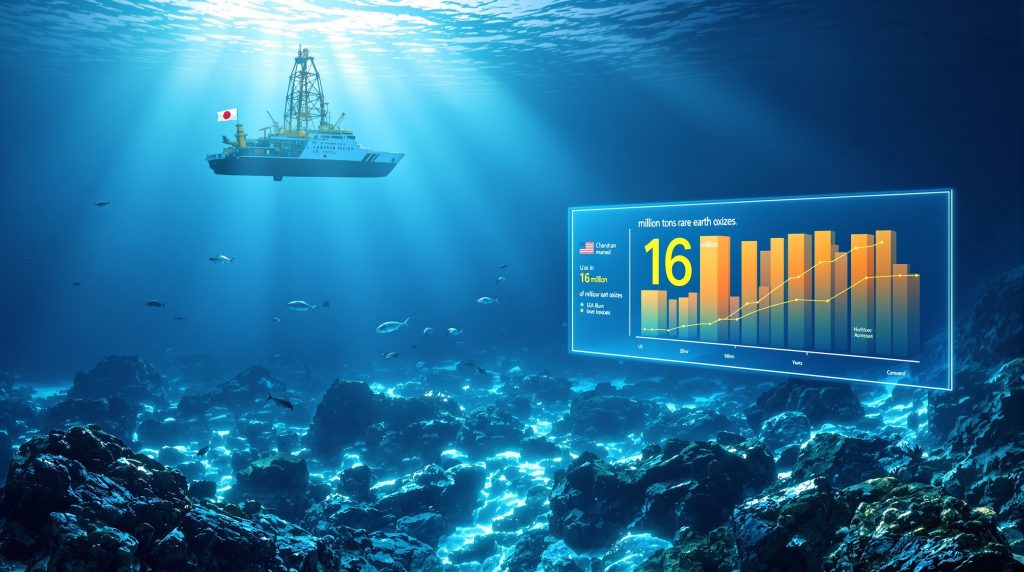Japan's Strategic Pivot Toward Ocean Floor Resources
Japan's unprecedented move toward Japan deep-sea rare earth mining represents a fundamental shift in global resource strategy. With China maintaining control over approximately 60% of worldwide rare earth production, nations are scrambling to establish alternative supply chains for materials essential to modern technology, defense systems, and clean energy infrastructure.
Prime Minister Sanae Takaichi's recent announcement signals Japan's commitment to exploring these underwater treasure troves, positioning the nation as a pioneer in what could become the next frontier of critical mineral extraction. This initiative follows decades of geological surveys and represents Japan's most ambitious attempt to achieve technological independence from Chinese rare earth dominance.
The timing coincides with broader geopolitical tensions and supply chain vulnerabilities exposed during recent global disruptions. Furthermore, this development follows patterns seen in uranium market volatility where supply diversification has become increasingly critical. Japan's approach combines cutting-edge marine technology with international partnerships, creating a template that other nations may follow in their quest for resource security.
Minamitori Island's Underwater Mineral Wealth
Located approximately 1,950 kilometres southeast of Tokyo, Minamitori Island sits above one of the world's most promising rare earth deposits. Scientific surveys conducted by the University of Tokyo and the Japan Agency for Marine-Earth Science and Technology have identified an estimated 16 million tons of rare earth oxides buried beneath 5,500 to 6,000 metres of Pacific Ocean water.
These extreme depths present unprecedented technical challenges, yet the potential rewards are extraordinary. The seabed deposits contain concentrated levels of critical elements that form the backbone of modern technology:
- Dysprosium: Essential for high-performance permanent magnets in wind turbines and electric vehicle motors
- Neodymium: Critical component enabling miniaturisation in electronics and automotive applications
- Gadolinium: Vital for medical imaging equipment and nuclear reactor control systems
- Terbium: Required for energy-efficient lighting systems and high-definition displays
The concentration ratios of these heavy rare earth elements significantly exceed those found in typical terrestrial deposits, making the Minamitori site particularly valuable despite extraction challenges. Unlike land-based mining operations, these underwater concentrations exist in fine-grained pelagic sediments enriched with ferromanganese hydroxides.
Comparative Resource Analysis
| Location | Estimated REE Content | Depth/Accessibility | Strategic Value |
|---|---|---|---|
| Minamitori Island | 16 million tons REO | 5,500-6,000m underwater | Extreme |
| China's Bayan Obo | 48 million tons REO | Surface accessible | Very High |
| California's Mountain Pass | 1.8 million tons REO | Surface accessible | High |
The Minamitori deposit's immense scale compensates for its challenging location. While extraction costs will substantially exceed terrestrial operations, the strategic value of domestic rare earth resources provides compelling justification for Japan's significant investment in this technology.
Revolutionary Deep-Sea Extraction Technology
The Japan Agency for Marine-Earth Science and Technology has developed an innovative extraction system utilising the research vessel Chikyu, one of the world's most advanced scientific drilling platforms. This sophisticated operation will pump sediment from the ocean floor through specialised pipeline networks, targeting a processing capacity of 350 tonnes of sediment daily by January 2027.
Three-Phase Development Strategy
Phase 1: Initial Testing (January 2026)
- Proof-of-concept drilling operations
- Equipment calibration and environmental baseline studies
- Technical feasibility validation
Phase 2: System Optimisation (2027)
- Full-scale processing trials
- Sediment separation technology refinement
- Environmental impact monitoring implementation
Phase 3: Commercial Assessment (2028+)
- Economic viability determination
- Regulatory compliance verification
- Long-term production planning
The extraction methodology involves hydraulic sediment lifting systems capable of operating under extreme pressures. Advanced umbilical cable networks will manage material flow and power delivery across the 6-kilometre vertical distance. Real-time sediment separation technology will concentrate rare earth elements during the extraction process, maximising efficiency and minimising environmental disruption.
This technological approach draws from proven deep-sea mining concepts tested in international polymetallic nodule collection programs, but represents a significant advancement in precision and scale. The Chikyu vessel's capabilities extend to 7,000+ metre depths, providing operational flexibility for the Minamitori project's requirements.
"Technical Innovation: The proposed system integrates petroleum industry riser technology with advanced marine robotics, creating unprecedented capabilities for deep-sea mineral extraction."
Strategic U.S.-Japan Minerals Partnership
The October 2024 U.S.-Japan critical minerals agreement creates a comprehensive framework for bilateral cooperation in deep-sea mining operations. This partnership extends far beyond simple resource sharing, establishing integrated supply chains and technological collaboration that strengthens both nations' strategic positions in the Indo-Pacific region.
Alliance Framework Components
American Investment Opportunities
- Direct funding for Japanese mining infrastructure
- Technology transfer agreements for advanced robotics
- Joint venture structures for commercial operations
Naval and Security Support
- Maritime domain awareness in extraction zones
- Logistics coordination for deep-sea operations
- Protection of critical infrastructure investments
Research and Development Collaboration
- Shared environmental monitoring protocols
- Advanced materials science partnerships
- Next-generation extraction technology development
This cooperation represents a strategic response to China's rare earth market dominance, creating alternative supply chains that reduce geopolitical vulnerabilities. The timing aligns with broader U.S. supply chain resilience initiatives and Japan's economic security strategies, similar to how Russian uranium import bans have reshaped nuclear fuel markets.
The partnership enables Japan to access American deep-sea mining expertise developed through decades of offshore oil and gas operations. Simultaneously, the United States gains access to Japan's advanced marine technology and precision manufacturing capabilities, creating synergistic benefits for both partners.
Environmental Challenges and Marine Ecosystem Concerns
Deep-sea rare earth mining presents complex environmental challenges that require unprecedented precautionary measures. The targeted extraction zones represent some of Earth's least understood ecosystems, where biological communities have evolved over millennia in stable, low-energy environments.
Primary Environmental Risks
Biodiversity Impact Concerns
- Destruction of unique deep-sea habitats that regenerate extremely slowly
- Potential extinction of endemic species in unexplored regions
- Disruption of complex deep-ocean food webs and nutrient cycles
Sediment Plume Effects
- Widespread particulate clouds affecting marine life across vast areas
- Contamination of water columns extending hundreds of kilometres
- Long-term habitat degradation in benthic ecosystems
Chemical Contamination Risks
- Release of heavy metals and toxic compounds from disturbed sediments
- Bioaccumulation of contaminants in marine food chains
- Potential impacts on commercial fisheries and marine mammals
Leading marine conservation organisations have called for comprehensive environmental impact assessments before any commercial operations begin. Oceania's deep-sea mining initiatives face similar scrutiny from environmental groups. The International Union for Conservation of Nature specifically recommends implementing strict precautionary principles that prioritise ecosystem protection over resource extraction.
"Critical Environmental Consideration: Unlike terrestrial mining operations, deep-sea extraction impacts are largely irreversible due to the extremely slow regeneration rates of abyssal ecosystems, which can require centuries to recover from disturbance."
Proposed Mitigation Measures
Japan's environmental monitoring protocols include real-time sediment plume tracking, marine life detection systems, and continuous water chemistry analysis. These measures represent industry-leading approaches to environmental stewardship in deep-sea mining operations.
International Legal Framework and Regulatory Compliance
Japan deep-sea rare earth mining activities operate within a complex web of domestic legislation and international treaties. The regulatory landscape requires careful navigation to ensure compliance while maintaining operational flexibility for this pioneering initiative.
Domestic Legal Structure
Primary Legislation
- Act on Interim Measures for Deep Seabed Mining (1982)
- Exclusive Economic Zone and Continental Shelf Act
- Marine Environment Protection statutes
Regulatory Oversight Bodies
- Ministry of Economy, Trade and Industry (METI)
- Japan Coast Guard maritime authority
- Environmental impact assessment agencies
International Treaty Obligations
United Nations Convention on the Law of the Sea (UNCLOS)
- Sovereign rights over EEZ mineral resources
- Environmental protection requirements
- International cooperation obligations
Biodiversity Beyond National Jurisdiction Agreement
- Marine protected area considerations
- Environmental impact assessment sharing
- International consultation requirements
The legal framework provides Japan with clear authority to develop mineral resources within its Exclusive Economic Zone while requiring environmental safeguards and international transparency. This regulatory structure supports commercial development while addressing global concerns about deep-sea ecosystem protection.
Market Disruption and Economic Impact Potential
Successful Japan deep-sea rare earth mining could fundamentally reshape global critical minerals markets, creating new competitive dynamics and supply chain configurations that extend far beyond Japan's domestic requirements.
Supply Chain Transformation
Market Diversification Benefits
- Reduced dependence on Chinese rare earth exports
- Enhanced price stability through competitive supply sources
- Improved supply security for technology manufacturers worldwide
Investment Sector Creation
- New maritime technology industries focused on deep-sea operations
- Specialised equipment manufacturing for extreme-depth mining
- Environmental monitoring and mitigation service providers
Strategic Reserve Implications
- National stockpiling strategies for critical materials
- Emergency supply protocols during geopolitical tensions
- Long-term resource security planning for allied nations
Economic Viability Challenges
Despite promising geological surveys, commercial viability remains unproven at current technology costs. Deep-sea extraction expenses substantially exceed terrestrial mining operations, requiring sustained high rare earth prices and technological breakthroughs to achieve profitability. In addition, recent trends in uranium spot price dynamics demonstrate how commodity markets can experience rapid volatility.
| Cost Factor | Terrestrial Mining | Deep-Sea Mining | Premium Multiplier |
|---|---|---|---|
| Initial Capital | $100-500M | $1-5B+ | 10-20x |
| Operating Costs | $5-15/kg REO | $50-150/kg REO | 10-15x |
| Environmental Compliance | $10-50M | $100-500M+ | 10-20x |
The economic equation depends heavily on technological advancement and scale economies that may emerge through operational experience. Japan's approach prioritises long-term strategic value over short-term profitability, reflecting the critical importance of rare earth supply security.
Global Competitive Response and International Interest
Japan deep-sea rare earth mining initiative has catalysed international interest in underwater mineral resources, creating competitive pressure among nations seeking to diversify their critical materials supply chains.
Pacific Region Development
United States Initiatives
- EEZ exploration programmes in Micronesian waters
- Deep-sea technology development partnerships
- Strategic mineral reserve planning integration
Regional Partner Activities
- Australia investigating Southern Ocean ferromanganese deposits
- New Zealand evaluating deep-sea mineral rights frameworks
- South Korea developing underwater robotics capabilities
However, traditional mining operations continue facing challenges. For instance, Paladin Energy operations have experienced recent setbacks, highlighting the broader industry's operational complexities.
Technology Development Competition
European Union Programmes
- Horizon Europe funding for deep-sea research initiatives
- Critical Raw Materials Act implementation support
- Environmental impact assessment methodology development
Private Sector Innovation
- International mining companies developing extraction technologies
- Robotics firms creating specialised deep-sea equipment
- Environmental consultancies expanding marine expertise
This international response demonstrates the strategic significance of Japan's initiative beyond its immediate resource objectives. The technology and experience gained through Minamitori operations could position Japan as a leader in the emerging deep-sea mining industry.
Investment Timeline and Commercial Production Expectations
Realistic expectations for Japan deep-sea rare earth mining initiative require understanding the extended development timeline and substantial capital requirements involved in this unprecedented undertaking.
Development Phase Projections
Short-term (2025-2027)
- Technology testing and system optimisation
- Environmental impact studies and regulatory approvals
- International partnership framework establishment
Medium-term (2028-2032)
- Pilot commercial operations and economic validation
- Production scaling and efficiency improvements
- Global market integration and supply chain development
Long-term (2033+)
- Full-scale commercial production capability
- Technology export opportunities to other nations
- Strategic reserve accumulation for national security
"Investment Reality Assessment: This initiative represents a long-term strategic hedge rather than an immediate production opportunity, requiring patient capital and substantial risk tolerance from investors and policymakers."
Financial Investment Requirements
Japan has allocated approximately JPY 300 billion (USD $2 billion equivalent) over the next decade for deep-sea mining research, technology development, and initial operations. This substantial commitment reflects the strategic priority placed on achieving rare earth independence.
Capital Allocation Breakdown
- Research and development: 40%
- Technology and equipment: 35%
- Environmental monitoring: 15%
- International partnerships: 10%
The extended timeline reflects both technical complexity and environmental responsibility requirements that distinguish this initiative from conventional mining projects. Furthermore, US uranium production demonstrates how domestic resource development requires sustained investment over many years. Investors should anticipate a decade-long development period before meaningful commercial production becomes feasible.
Strategic Lessons for Global Resource Security
Japan's comprehensive approach to deep-sea rare earth mining offers valuable insights for other nations considering similar initiatives to enhance critical mineral security and reduce geopolitical supply chain vulnerabilities.
International Cooperation Framework
Bilateral Partnership Benefits
- Risk sharing reduces individual nation exposure to technical and financial challenges
- Technology sharing accelerates development timelines and reduces costs
- Diplomatic coordination prevents international conflicts over resource claims
Multilateral Coordination Opportunities
- Environmental monitoring protocols developed collaboratively
- Regulatory frameworks harmonised across jurisdictions
- Market integration strategies designed to benefit all participants
Environmental Leadership Standards
Proactive Assessment Strategies
- Comprehensive ecological surveys before operational commencement
- Real-time environmental monitoring throughout extraction phases
- Transparent reporting mechanisms to maintain international credibility
Sustainable Development Integration
- Long-term ecosystem protection prioritised over short-term resource extraction
- Community stakeholder engagement in planning and implementation
- Adaptive management approaches that respond to new scientific understanding
Economic Strategy Principles
Strategic Planning Over Immediate Returns
- Long-term resource security objectives prioritised over quarterly profit maximisation
- Technology development investments that create exportable capabilities
- Market diversification strategies that reduce single-source dependencies
Risk Management Through Diversification
- Multiple extraction sites to reduce operational vulnerabilities
- Varied partnership structures to distribute financial and technical risks
- Flexible operational capabilities that adapt to changing market conditions
Japan's methodical approach demonstrates how nations can balance resource security objectives with environmental responsibility and international cooperation. This framework provides a replicable model for responsible critical mineral development in marine environments. Moreover, advanced deep-sea mining technologies continue evolving to address technical challenges.
The Minamitori Island initiative represents more than resource extraction; it embodies a strategic vision for technological independence, environmental stewardship, and international collaboration that could reshape how nations approach critical mineral security in the 21st century.
Disclaimer: This analysis includes forward-looking statements about technological development and market conditions that involve inherent risks and uncertainties. Deep-sea mining commercial viability remains unproven, and environmental impacts require ongoing scientific assessment. Investment decisions should consider the speculative nature of emerging deep-sea mining technologies and extended development timelines.
Are You Tracking the Next Generation of Strategic Mineral Investments?
Japan's deep-sea rare earth mining initiative exemplifies the type of groundbreaking resource developments that can reshape entire markets and create exceptional investment opportunities. Discovery Alert's proprietary Discovery IQ model provides instant notifications on significant ASX mineral discoveries, helping subscribers identify actionable opportunities in critical minerals and emerging sectors ahead of the broader market. Begin your 30-day free trial at Discovery Alert today and position yourself to capitalise on tomorrow's strategic resource developments.




